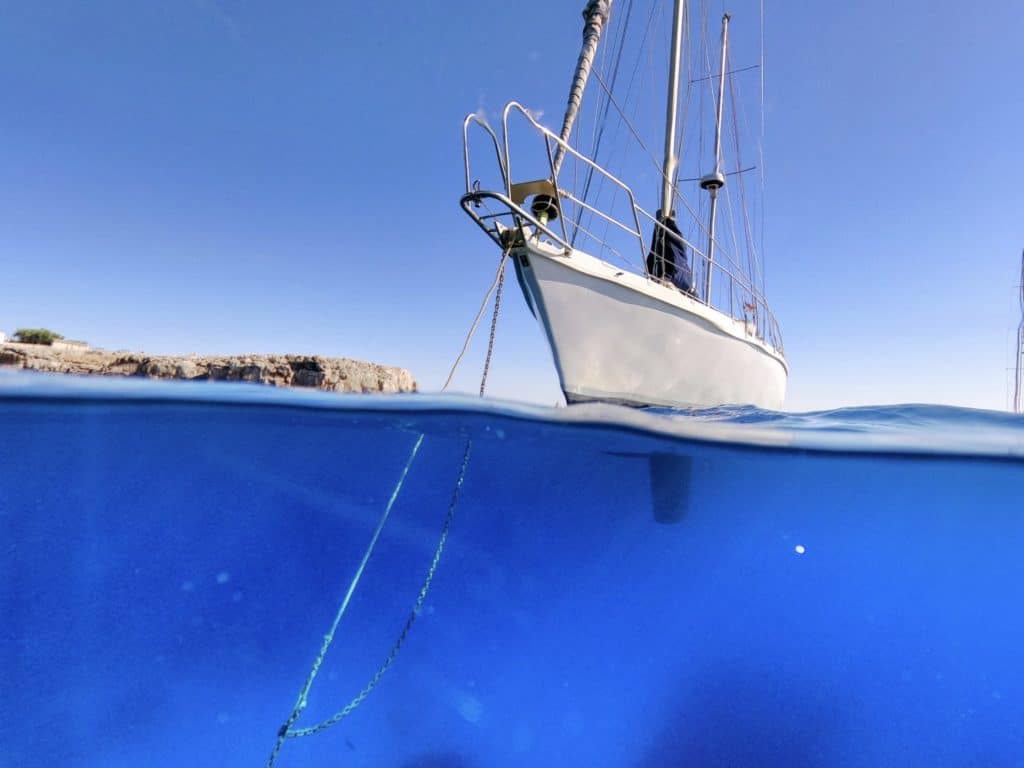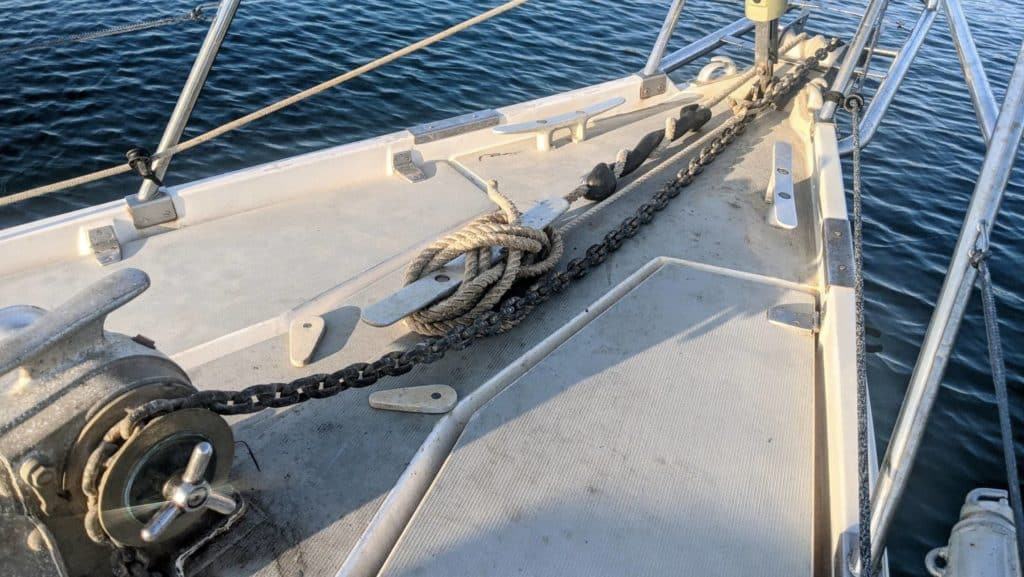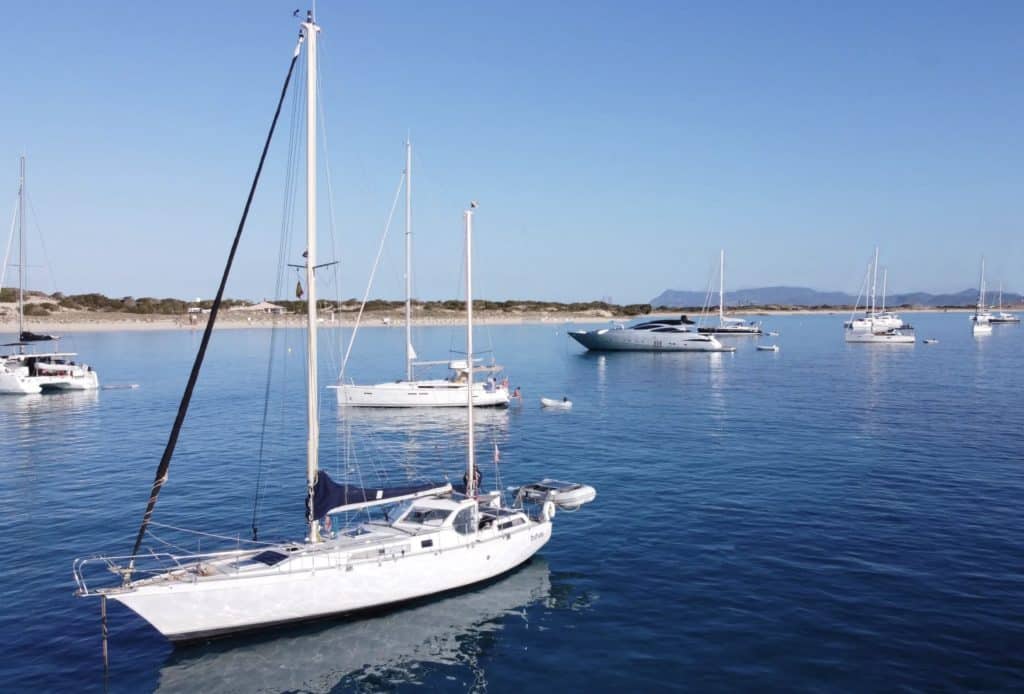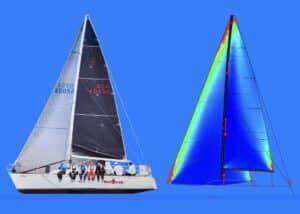
By Darren Seltzer who is sailing around the world with his wife Amanda on their Amel Sharki, a 39-foot ketch.
For those seeking to venture further than the local marinas or mooring fields, anchoring will become a necessary and vital skill set. Now, there are many great anchoring guides, and our advice should be taken as an addition to those lessons and techniques from experienced and qualified sailors. In our time cruising across the North Atlantic, from the Caribbean, Greenland, Scotland and Europe, we have learned some valuable tips while exploring some terrific anchorages. Here is what we have learned!
Let’s leave it to the armchair sailors and endless internet debates on ‘what type of anchor is best.’ However, in our humble opinion, we believe the “HOW” you anchor, the scope, snubber, and bottom type are way more important than just the anchor style. We truly believe you should always use a good amount of scope, plus a long elastic snubber. For scope, the minimum we ever use is 3:1, typical for a busy Mediterranean anchorage. Our usual is 5:1, and, for any winds up to about 20 kts, we go to 7:1 and up to 10:1 in a real nasty situation.


For reference, scope is the ratio between water depth and length of anchor rode. If we see 4 m on the depth sounder, we then add 1 m for the height up to the bow roller, for a total of 5 m. Multiply 5 by our targeted 5:1 scope gives us 25 m. For our snubber, we have a long length of 3/4″ 3-strand with one of those rubber dock-line snubber devises in-line (see photo). In this example, we would typically let out 20 m at the windlass, attach our snubber line using our Dyneema soft shackle (we love this solution by the way!), for a total of about 35 m. The snubber is very important as it dampens violent shock loads directly on the anchor chain, and thus to the anchor. A yacht anchor dug into the bottom can be thought of as glass – a material which can withstand high loads, but absolutely brittle to shock loading. Your snubber line and proper scope keep all that motion away from the anchor.
Backing Down. Equally importance as the calculation of scope is the final step in setting anchor. Gently but firmly back down on the anchor to make sure it’s set into the bottom. Going back to the glass analogy: when applying some reverse thrust from the engine, do this ever so gently. Usually, we will let the wind take us back, and in a light breeze it will partially set. Then we engage reverse, but only for 5 seconds. This gets the momentum of a heavy cruising boat loading up that anchor chain. The bow person will then call out ‘taught,’ meaning the chain is loaded, at which point we engage reverse again, and now much higher RPM. This prevents a very harsh snatch-loading on the system, which, when the anchor isn’t fully set, will quickly release the anchor from the ground and it can skip over the bottom as the boat picks up speed. No anchor stands a chance with the momentum of a cruising boat! If, at any point the anchor becomes dislodged, and you can feel it skipping by putting your hand on the rode as the boat back down. If it skips, we can usually get it set by gently backing down again. If not, this may indicate the bottom is not suitable, and we repeat the process in a slightly different location.

Now that you are firmly secured to mother earth, you can relax and enjoy the scenery of your choosing, whether that be a city-scape, sea-scape, or landscape. Thank you for reading, we hope you enjoyed this article and hope to see at the next anchorage! If you wish, follow our Journey on YouTube at Sailing Panda. Happy Anchoring!






Thanks for the sensible tips. Just a detail on the snubber: apart from reducing shock loads on the anchor it also takes load and shocks off the windlass.
Thanks for the sensible tips. Just a detail on the snubber: apart from reducing shock loads on the anchor it also takes load and shocks off the windlass.
Hi sailors Helen and I are new to the club but have a combined ocean mileage of over 100,000 nm . Anchoring is a black art in clear blue water easy to dive down on it to see if it’s set. In the end we decided to anchor backwards so the person on the helm see’s the sand you want and shouts to the bow to warm them a good spot is going to appear very soon under the bow and release every thing that you have prepared. This is also a far better way to moor to a bouy taking a long line from the bow to the stearn of the boat so the helm and foredeck crew no longer shout at each other for hours afterwards. Our last boat was 15 m and 22 ton . Paul and Helen old sea salts
Hi sailors Helen and I are new to the club but have a combined ocean mileage of over 100,000 nm . Anchoring is a black art in clear blue water easy to dive down on it to see if it’s set. In the end we decided to anchor backwards so the person on the helm see’s the sand you want and shouts to the bow to warm them a good spot is going to appear very soon under the bow and release every thing that you have prepared. This is also a far better way to moor to a bouy taking a long line from the bow to the stearn of the boat so the helm and foredeck crew no longer shout at each other for hours afterwards. Our last boat was 15 m and 22 ton . Paul and Helen old sea salts